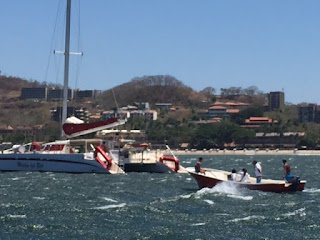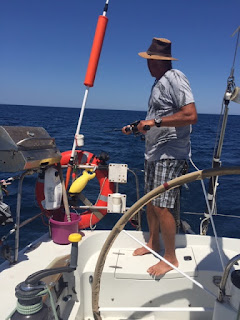We arrived at Playas el Cocos on a Friday
afternoon, hoisted a yellow flag, loaded our passports and boat docs into the
dinghy and headed in to see the Port Captain and the Immigration office. In Spanish, Cerrado means closed. In this case, cerrado meant closed for the
weekend. Lucky for us, in Costa Rica
they don’t believe in walls and no one cared at all that there were two
undocumented illegal aliens in their country, roaming their streets, drinking their
beer and eating up the food in their restaurants.
Cocos is a northern hub of beach tourist
hedonism, pretty much an “ask and ye shall receive” sort of place. Scuba diving, zip lining, kite surfing,
nature tours, you name it. Compared to
Nicaragua it also seemed very first-world, providing us with a dose of re-entry
culture shock. The weekend eventually
came to an end and with it, a taste of Costa Rican bureaucracy. Our clearance requirements
included the following order of “visitas de officinas,” each accompanied by a
lengthy wait: First to the Officina de Capitania del Puerto, then up the street
to the Officina de Immigracion, then back to the Capitania del Puerto, next up,
a one-hour round trip cab ride to the Airport to complete our Customs Clearance.
Then we returned to the Capitania del Puerto, and as any reasonable person
would obviously expect, the following day paid yet another visit to the
Capitania del Puerto. Leaving Cocos we were feeling very well documented
indeed.
Next stop was Bahia Brasilito a gorgeous
little bay a couple hours cruise south. Lovely sail, lovely bay all to
ourselves, lovely sunset, great sleep, delicious breakfast, and do you remember
“that guy”? It turns out that thumbing
your nose at gods is a really bad idea. Leaving
Brasilito we headed to Tamarindo and just as we were entering the anchorage, El
Papagayo showed up. “You are not supposed to be here,” we said to him. “Well here I am” said he and immediately
gusted to 45 knots. Sometimes sailing,
especially when entering an anchorage, you can get stymied; what you want to do
you simply can’t. When there is too much wind the thing to do is shorten or
douse sails, which first requires heading upwind. Unfortunately, immediately in
that direction was a dangerous underwater rock pile, so nope, not doing that. Oh
look, there is a tear in the mainsail! Thanks, Papy, we’ll hold our course past
the rocks and let the mainsail rip some more before we douse it, ok? “Welcome to Bahia Tamarindo” said he, “I also know
how much you like loud, windy anchorages so I’ve got you all set up for the
night.”
In the morning we set out southward. God’s reach only goes so far and according to
all weather guidance, Papagayo turns into a shrivelled little worm if you get
far enough south. So we motor-sailed under
jib alone while el Papagayo continued inflicting his fickle form of torment:
just the right breeze, now nothing, now 40, now again nothing, and so on.
Bahia Corrillo was a nice little stop that after a short walk up a dirt road brought us to a french restaurant surprise. Chez Nous is themed in the bright colours of Gauguin and run by a couple of french fellows who ten years earlier had relocated from paradise in French Polynesia to a new one in Costa Rica.
Bahia Corrillo was a nice little stop that after a short walk up a dirt road brought us to a french restaurant surprise. Chez Nous is themed in the bright colours of Gauguin and run by a couple of french fellows who ten years earlier had relocated from paradise in French Polynesia to a new one in Costa Rica.
Eventually we reached Bahia Ballenas and
anchored in settled winds. A morning dinghy trip revealed Ballenas to be a bay of
broken dreams. Spalling concrete steps
at the wharf led to the now abandoned Yacht Club, apparently once a happening
place but now in a condition of sad dereliction. A walk to the little town showed mostly closed
restaurants and stores. Greg had hoped to play a game of golf but getting to
the course required a 4 mile walk and there were no taxis. Guessing that the effort would not be worth
it anyway, we spent a rolly-polly night on the hook, the morning applying
sticky-patch to the mainsail and left in the afternoon for the nearby Islas
Tortugas.
With better
weather, to a sailor comes a whole new attitude. Snorkeling with the tour group swimmers and various
colourful little fishes we began to appreciate Costa Rica’s abundant nature. After
another short sail to the wildlife reserve at Bahia Curu, we anchored
again. Ashore was a view verdant with
tropical greenery and promise for the day ahead. Our plan was to rise early, take a nature
trek and commune with lions, tigers and bears.
There were none
of those animals but there were crocodiles, white-face catuchins and howler monkeys, deer,
birds of many feathers, coaties (they look a lot like racoons), a horse (wild?),
and a startled snake on the trail that Alice, walking ahead, claimed was a fer-de-lance
(instant death bite).
A need for fuel and provisions has now
brought us to Bahia Herradura, where uber-rich types hang out at the marina in
a harbour chock-full of ridiculously expensive 70 ft fishing machines. Apparently, they hold monthly fishing derbies
here where the prizes awarded to the winner can approach $1M USD. Fishermen, especially rich ones, are capable of
astonishing behaviour in search of their prey.
The marina here caters to such humans. We were slightly amused when the marina management treated us as some form of sea-going riff-raff, definitely not of the sort welcome here. Asking about the possibility of taking a few nights moorage at the marina, we were denied. The truth is we probably wouldn't have been willing to pay their exorbitant
price anyway. They did sell us fuel, so we were happy for that and are now anchored in the bay.
Greg & Alice
Arrived in Costa Rica
Anchorage at Cocos
Brasilito
A windy day at anchorage in Tamarindo.
Calm anchorage at Carrillo.
Scarlet Macaw in the French Restaurant.
Pool toy
Catching lots of fish but rarely ones that are good eating.
Rounding Cabo Blanco.
Cabo Blanco would be no fun to wash up on.
Fish wharf at Bahia Ballenas.
Derelict Costa Rica Yacht Club.
Tour boat looking at us, looking at them.
Banana boat at Islas Tortugas.
Beach at Curu.
Interesting shrine meaning what?
Aboreal termite nests stay still in one place and are easy to photograph.
Ceiba tree roots can scare people that are afraid of snakes.
Mangrove roots.
Bridge over crocodiles
Estuary to the sea
Los Suenos Marina at Herradura































